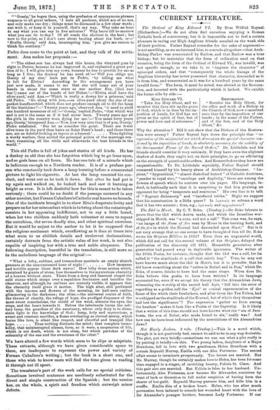The Idol in Horeb. By C. T. Beke. (Tinsley.)—Dr. Bake
labours to prove that the idol which Aaron made, and which the Israelites wor- shipped in Horeb, was "a cone, and not a calf." This cone was, he says, "an image of the flame of fire seen by Moses in the burning bush, and of thefire in which the Eternal had descended upon Sinai." But is it not very strange that no one seems to have thought of this till Dr. Bake wrote his Origines Biblicce in 1833? Even then an ungrateful world, which did not call for the second volume of the Origines, delayed the
publication of the discovery till 1871. Meanwhile generation after
generation had passed away in deplorable ignorance. The writer of the 105th Psalm, for instance, thought that the idol was a calf, for he
called it "the similitude of a calf that eateth hay." True, he may not
have known much about the idol in Horeb, but it is probable, that he did know something about the "calves in Bethel and in Dm," which Dr.
Bake, of course, thinks to have had the same shape. When does Dr. Bake believe this psalm to have been written ? Is its language accounted for, even if we accept his theory that the Alexandrian Jews, witnessing the worship of the sacred bull Apia, "fell into the error of regarding as a golden calf the 'Ege/' or conical representation of the flame of fire which their forefathers, and after them the Ten Tribes, had worshipped as the similitude of the Eternal, but of which they themselves had lost the significance "? The expression "gather us from among the heathen" makes it look like a Psalm of the Captivity. Is it likely that a writer of this time should not have known what the "sin of Jero- boam, the son of Nebat, who made Israel to sin," really was ? And how can he have been influenced by the associations of the Alexandrian Jews?


































 Previous page
Previous page